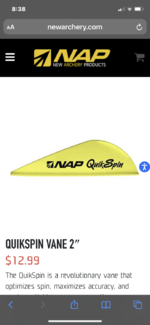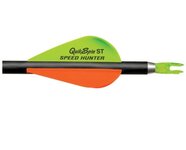Hi all, this is my first post but I've lurked threads here for a while. You folks have a great community and I'm glad to be part of it.
I realize fletching configurations have been talked to death, and I've read dozens of relevant threads but I'm still left with a few questions...
1) Why has it been stated that fletching profile HEIGHT rather than edge area or total surface area is most important to steering fixed blades? Is it due to the distance from the centroid of the arrow on which lateral forces (wind) act on the fletch must be ≥ that of the broadhead?
2) Which configuration imparts more drag: 4 fletch offset or 3 fletch helical? Assuming there's an adequate compensation for surface area between 4 smaller vanes and 3 larger vanes so the surface area is about equal (say 4 offset fletch 2.1" 2Qi fusions vs 3 helical fletch 3" 2Qi fusions)
3) Is 4 fletch with 3 blade fixed a grave sin? Some people claim indexing matters some don't its all contradictory from what I've read.
Looking to understand the science, anecdotal accounts are great but reading them has left me with these questions.
Basically I want an arrow I can shoot long range target (70+ yards) and also use the same arrow to stabilize cut on contact 3 blade (QAD Exodus) for colorado elk (not taking animals past 60 yds). I'm using 250 spine rampage .001s with the 51gr half out and 100gr tips shooting out of an RX4 ultra with a QAD HDX (probably upgrading to hamskea at some point). Not a fan of blazers due to noise and clearance, considering building 4 fletch with fusion 2.1s or 3 fletch helical with fusions 3"s or 2.7" max stealths. Plus if I'm building myself might as well do something that looks cool (stupid but hey so am I). Shafts are tuned to my bow.
I realize fletching configurations have been talked to death, and I've read dozens of relevant threads but I'm still left with a few questions...
1) Why has it been stated that fletching profile HEIGHT rather than edge area or total surface area is most important to steering fixed blades? Is it due to the distance from the centroid of the arrow on which lateral forces (wind) act on the fletch must be ≥ that of the broadhead?
2) Which configuration imparts more drag: 4 fletch offset or 3 fletch helical? Assuming there's an adequate compensation for surface area between 4 smaller vanes and 3 larger vanes so the surface area is about equal (say 4 offset fletch 2.1" 2Qi fusions vs 3 helical fletch 3" 2Qi fusions)
3) Is 4 fletch with 3 blade fixed a grave sin? Some people claim indexing matters some don't its all contradictory from what I've read.
Looking to understand the science, anecdotal accounts are great but reading them has left me with these questions.
Basically I want an arrow I can shoot long range target (70+ yards) and also use the same arrow to stabilize cut on contact 3 blade (QAD Exodus) for colorado elk (not taking animals past 60 yds). I'm using 250 spine rampage .001s with the 51gr half out and 100gr tips shooting out of an RX4 ultra with a QAD HDX (probably upgrading to hamskea at some point). Not a fan of blazers due to noise and clearance, considering building 4 fletch with fusion 2.1s or 3 fletch helical with fusions 3"s or 2.7" max stealths. Plus if I'm building myself might as well do something that looks cool (stupid but hey so am I). Shafts are tuned to my bow.


